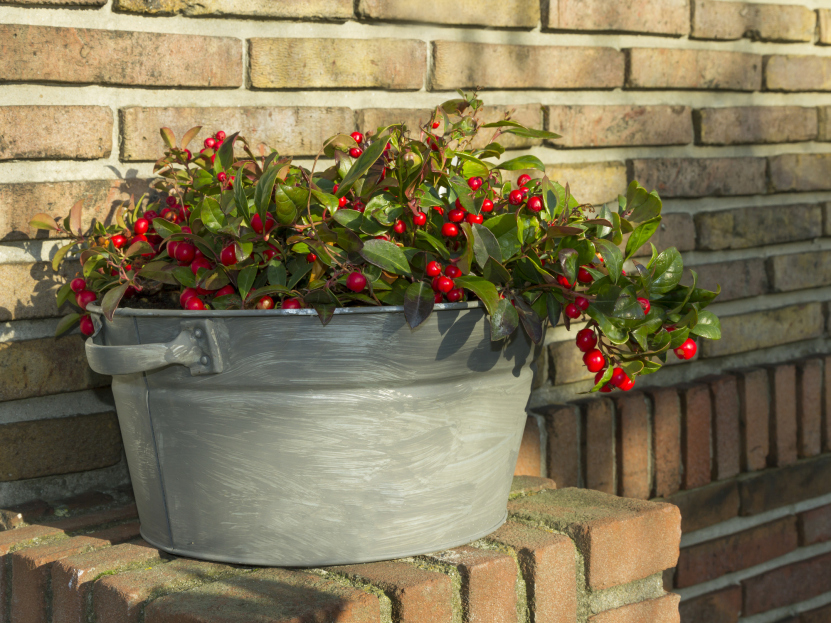
Gaultheria, commonly known as wintergreen or teaberry, is a beautiful and hardy evergreen plant that can make a charming addition to your indoor plant collection. With its glossy green leaves and bright red berries, Gaultheria adds a pop of color and texture to any space. While it’s more commonly grown outdoors, Gaultheria can also thrive indoors with the right care. Here’s a guide on how to care for your Gaultheria houseplant.
Gaultheria prefers bright, indirect light but can also tolerate some direct sunlight. However, too much direct sun can scorch its leaves, so it’s best to place it near a window with filtered light or in a location where it gets a few hours of morning sunlight. If you don't have access to enough natural light, you can supplement with artificial grow lights to ensure the plant receives enough light to grow and produce berries. Avoid placing it in dark corners or areas with too little light, as this can stunt its growth.
Gaultheria likes moist, well-draining soil, but it does not like to sit in water. Water your Gaultheria when the top inch of soil feels dry to the touch, ensuring that you water thoroughly but allow any excess water to drain away. It’s important not to let the plant sit in standing water, as this can lead to root rot. During the warmer months, you may need to water more frequently, while in winter, when the plant is dormant, you can reduce watering. Be sure to check the soil regularly to ensure it doesn't dry out completely or become waterlogged.
Gaultheria thrives in moderate to high humidity. If your home is dry, especially during the winter months when indoor heating can lower humidity levels, it’s a good idea to increase the moisture in the air around your plant. You can do this by placing a humidity tray filled with water and pebbles under the plant or by using a humidifier. Grouping plants together can also help create a more humid microenvironment. Just be sure not to let the plant sit in a drafty area or near a heat source, as this can cause stress to the plant.
Gaultheria prefers cool to moderate temperatures, ideally between 50-65°F (10-18°C). It’s best to keep the plant in a room that doesn’t get too hot or too cold. Gaultheria is quite hardy and can tolerate cooler temperatures, but it should be protected from frost if grown indoors. Avoid placing it in areas with fluctuating temperatures, such as near radiators, air conditioners, or vents, as sudden temperature changes can stress the plant.
Gaultheria thrives in acidic, well-draining soil. A peat-based potting mix with added perlite or sand for drainage works well for this plant. It’s important to ensure that the soil doesn’t become compacted, as Gaultheria’s roots prefer loose, aerated soil. If the soil is too alkaline, the plant may not grow well, so using an acidic mix is crucial. You can also add organic matter like compost to improve the soil’s fertility and drainage.
Gaultheria is a relatively low-maintenance plant when it comes to fertilizing. During the growing season (spring and summer), feed your plant with a balanced, water-soluble fertilizer diluted to half strength every 4-6 weeks. This will provide the necessary nutrients for healthy growth. In the fall and winter, when the plant is dormant, you can stop fertilizing altogether. Over-fertilizing can lead to excessive growth and fewer berries, so it’s best to avoid fertilizing too often.
Gaultheria doesn’t require heavy pruning, but you can trim back any dead or damaged leaves to keep the plant looking tidy. If the plant becomes too leggy or overgrown, you can also prune it to shape. Pruning is best done in early spring, before the plant begins its active growing season. Use clean, sharp scissors or pruning shears to remove any unwanted growth, and be sure to sterilize your tools before and after pruning to prevent the spread of disease.
Gaultheria doesn’t need frequent repotting, but if it becomes root-bound or the soil has become compacted, it’s a good idea to repot it into a slightly larger container. Choose a pot with good drainage to prevent water from accumulating at the bottom. Repotting is best done in early spring, just before the growing season begins. When repotting, gently remove the plant from its current pot, trim any damaged or dead roots, and place it in fresh, acidic soil.
Gaultheria is generally considered non-toxic to pets. However, while the plant itself is not poisonous, it’s always a good idea to keep it out of reach of pets that may be tempted to chew on the leaves or berries. If your pet does ingest any part of the plant, it’s unlikely to cause harm, but it’s always best to monitor for any signs of gastrointestinal upset and contact your vet if needed.